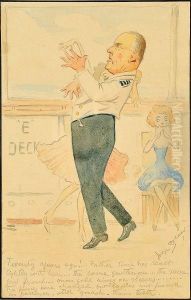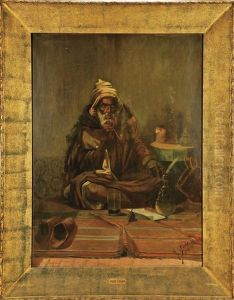Jorge Colaco Paintings
Jorge Colaço was a Portuguese artist, best known for his work with azulejos, the traditional ceramic tiles that are a hallmark of Portuguese architecture and decorative arts. Born on February 14, 1868, in Tanger, Morocco, to Portuguese parents, Colaço demonstrated an early interest in art. His family's return to Portugal when he was a child provided him the opportunity to immerse himself in the rich cultural heritage that would later greatly influence his artistic career.
Colaço studied painting in Lisbon and then continued his education in Paris, where he was exposed to various artistic movements and techniques. Despite this exposure, it was his work with azulejos that established his reputation. He is credited with reviving the 16th-century Portuguese tradition of azulejo panels, which had waned in popularity by the 19th century. Colaço's works often depict historical and cultural scenes, imbued with a sense of nationalism and romanticism, reflecting Portugal's past glories and cultural achievements.
Throughout his career, Colaço undertook numerous commissions, and his work decorated public and private buildings, churches, palaces, and railway stations, not only in Portugal but also in the Portuguese colonies of the time. One of his most famous works is the São Bento Railway Station in Porto, Portugal, where his tile panels portray various historical battles and the history of transportation. The station is considered one of the world's most beautiful railway stations, largely due to Colaço's expansive azulejo murals.
Jorge Colaço's contribution to Portuguese art cannot be overstated. He played a pivotal role in the revival of the azulejo as a form of national expression and left a lasting legacy that continues to be celebrated in Portugal and beyond. His work remains a vibrant part of Portuguese culture, attracting tourists and art enthusiasts to the sites adorned with his intricate and colorful tilework. Colaço passed away on May 1, 1942, but his artistic vision lives on through the many surfaces that tell the story of Portugal's rich history and traditions.



